Hybrid-SegUFormer: A Hybrid Multi-Scale Network with Self-Distillation for Robust Landslide InSAR Deformation Detection
Highlights
- Hybrid-SegUFormer achieves effective landslide InSAR deformation detection performance (IoU: 66.74%, F1-score: 80.05%) through synergistic integration of segFormer encoder, multi-scale decoder and self-distillation mechanism.
- Hybrid-SegUFormer demonstrates exceptional multi-scale adaptability with minimal performance degradation and strong cross-regional generalization capability, maintaining superior metrics on unseen datasets and demonstrating its practical utility.
- This study offers a reliable and efficient solution for large-area landslide deformation zone detection using InSAR data in rugged terrains.
- By demonstrating strong cross-regional generalization, Hybrid-SegUFormer reduces the need for localized data collection, facilitating more efficient large-area landslide early warning and risk mitigation.
Abstract
1. Introduction
2. Study Area and Data
2.1. Study Area
2.2. Data
2.2.1. SAR Data and Ancillary Data
2.2.2. Multi-Source Geo-Data for Eliminating Non-Landslide Deformation Areas
3. Methods
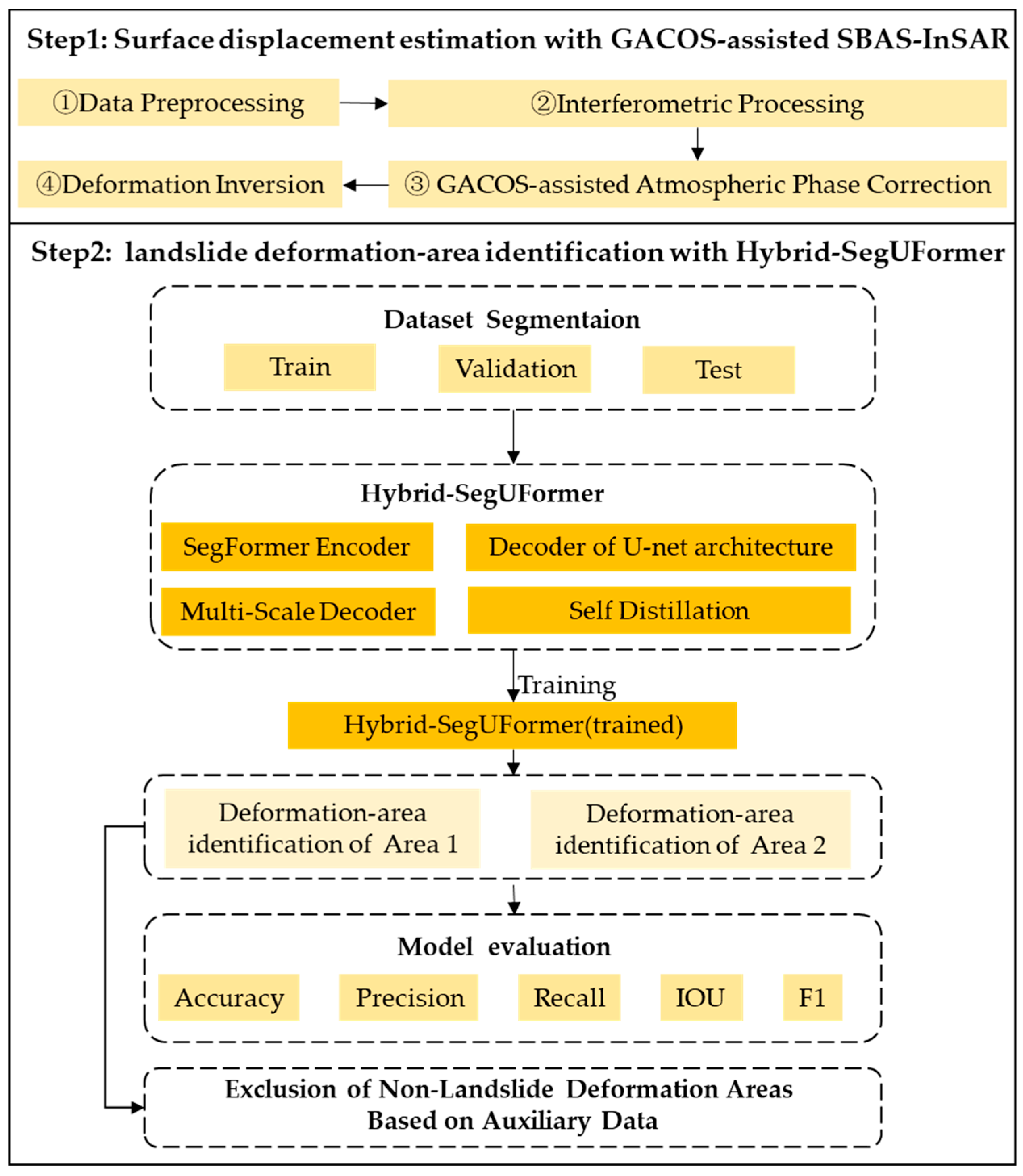
3.1. Surface Displacement Estimation with GACOS-Assisted SBAS-InSAR
3.2. Structure of Hybrid-SegUFormer
3.3. Encoder
3.4. Hierarchical U-Net Decoder
3.5. Multi-Scale Decoder
3.6. Online Self-Distillation Mechanism
3.7. Evaluation Metrics
- TP (True Positives): Correctly predicted landslide deformation pixels;
- TN (True Negatives): Correctly predicted non-landslide pixels;
- FP (False Positives): Non-landslide pixels misclassified as deformation;
- FN (False Negatives): Landslide deformation pixels missed by the prediction.
4. Results and Analysis
4.1. Results of the SBAS-InSAR Deformation Estimation
4.2. Sample Preparation
4.3. Model Comparative Experiments
4.4. Ablation Studies
4.5. Evaluation of Multi-Scale Perception Capabilities Across Models
4.6. Ablation Study on Multi-Scale Perception Capabilities
4.7. Model Transferability Validation
4.8. Exclusion of Non-Landslide Deformation Areas Based on Auxiliary Data
5. Discussion
5.1. Superiority of Model Performance
5.2. Synergistic Contribution of Core Modules
5.3. Exceptional Multi-Scale Perception Ability
5.4. Validation of Model Transferability
5.5. Comparative Analysis with Related Studies
5.6. Limitations and Future Work
6. Conclusions
Author Contributions
Funding
Data Availability Statement
Acknowledgments
Conflicts of Interest
References
- Hungr, O.; Leroueil, S.; Picarelli, L. The Varnes Classification of Landslide Types, an Update. Landslides 2014, 11, 167–194. [Google Scholar] [CrossRef]
- Huang, R. Large-scale landslides and their sliding mechanisms in china since the 20th century. Chin. J. Rock Mech. Eng. 2007, 26, 433–454. [Google Scholar]
- Yin, Y.; Wang, F.; Ping, S. Landslide Hazards Triggered by the 2008 Wenchuan Earthquake, Sichuan, China. Landslides 2009, 6, 139–151. [Google Scholar] [CrossRef]
- Kirschbaum, D.; Kapnick, S.B.; Stanley, T.; Pascale, S. Changes in Extreme Precipitation and Landslides Over High Mountain Asia. Geophys. Res. Lett. 2020, 47, e2019GL085347. [Google Scholar] [CrossRef]
- Zeng, T.; Guo, Z.; Wang, L.; Jin, B.; Wu, F.; Guo, R. Tempo-Spatial Landslide Susceptibility Assessment from the Perspective of Human Engineering Activity. Remote Sens. 2023, 15, 5549. [Google Scholar] [CrossRef]
- Hürlimann, M.; Guo, Z.; Puig-Polo, C.; Medina, V. Impacts of Future Climate and Land Cover Changes on Landslide Susceptibility: Regional Scale Modelling in the Val d’Aran Region (Pyrenees, Spain). Landslides 2022, 19, 99–118. [Google Scholar] [CrossRef]
- Yin, Y.; Wang, H.; Gao, Y.; Li, X. Real-Time Monitoring and Early Warning of Landslides at Relocated Wushan Town, the Three Gorges Reservoir, China. Landslides 2010, 7, 339–349. [Google Scholar] [CrossRef]
- Xu, Q.; Zhu, X.; Li, W.; Dong, X.; Dai, K.; Jiang, Y.; Lu, H.; Guo, C. Technical Progress of Space-Air Ground Collaborative Monitoring of Landslide. Acta Gcodaetica Cartogr. Sin. 2022, 51, 1416–1436. [Google Scholar] [CrossRef]
- Zhao, W.; Zhang, M.; Ma, J.; Qi, G.; Zhu, S.; Huang, Z. Research, Development, and Field Trial of the Universal Global Navigation Satellite System Receivers. IOP Conf. Ser. Earth Environ. Sci. 2020, 570, 62048. [Google Scholar] [CrossRef]
- Zhao, W.; Zhang, M.; Ma, J.; Han, B.; Ye, S.; Huang, Z. Application of CORS in Landslide Monitoring. IOP Conf. Ser. Earth Environ. Sci. 2021, 861, 42049. [Google Scholar] [CrossRef]
- Li, X.; Zhou, L.; Su, F.; Wu, W. Application of InSAR Technology in Landslide Hazard: Progress and Prospects. Natl. Remote Sens. Bull. 2021, 25, 614–629. [Google Scholar] [CrossRef]
- Vern, S.; Pierre-Jean, A.; Rejean, C.; Valentin, P. InSAR Monitoring of Landslides on Permafrost Terrain in Canada. In Proceedings of the IEEE International Geoscience and Remote Sensing Symposium (IGARSS 2007), Barcelona, Spain, 23 July 2007. [Google Scholar]
- Antoni, W.; Zbigniew, P.; Ramon, H. InSAR Analyses of Terrain Deformation near the Wieliczka Salt Mine, Poland. Eng. Geol. 2009, 106, 58–67. [Google Scholar] [CrossRef]
- Wang, G.; Xie, M.; Chai, X.; Wang, L.; Dong, C. Application of D-InSAR Technique to Landslide Monitoring in Wide Reservoir Area. China Min. Mag. 2011, 20, 94–101. [Google Scholar]
- Lu, H.; Li, W.; Xu, Q.; Dong, X.; Dai, C.; Wang, D. Early Detection of Landslides in the Upstream and Downstream Areas of the Baige Landslide, the Jinsha River Based on Optical Remote Sensing and InSAR Technologies. Geomat. Inf. Sci. Wuhan Univ. 2019, 44, 1342–1354. [Google Scholar] [CrossRef]
- Yin, Y.; Xu, S.; Wang, J.; Hu, K. Identification and Time Series Monitoring of Hidden Dangers of Geological Hazards in the Typical Loess Hilly Regions. Hydrogeol. Eng. Geol. 2023, 50, 141–149. [Google Scholar] [CrossRef]
- Liu, X.; Zhao, C.; Zhang, Q.; Lu, Z.; Li, Z.; Yang, C.; Zhu, W.; Liu-Zeng, J.; Chen, L.; Liu, C. Integration of Sentinel-1 and ALOS/PALSAR-2 SAR Datasets for Mapping Active Landslides along the Jinsha River Corridor, China. Eng. Geol. 2021, 284, 106033. [Google Scholar] [CrossRef]
- Mondini, A.C.; Guzzetti, F.; Chang, K.-T.; Monserrat, O.; Martha, T.R.; Manconi, A. Landslide Failures Detection and Mapping Using Synthetic Aperture Radar: Past, Present and Future. Earth-Sci. Rev. 2021, 216, 103574. [Google Scholar] [CrossRef]
- Cai, J.; Zhang, L.; Dong, J.; Dong, X.; Li, M.; Xu, Q.; Liao, M. Detection and Characterization of Slow-Moving Landslides in the 2017 Jiuzhaigou Earthquake Area by Combining Satellite SAR Observations and Airborne Lidar DSM. Eng. Geol. 2022, 305, 106730. [Google Scholar] [CrossRef]
- Zhang, L.; Liao, M.; Dong, J.; Xu, Q.; Gong, J. Early Detection of Landslide Hazards in Mountainous Areas of West China Using Time Series SAR Interferometry-A Case Study of Danba, Sichuan. Geomat. Inf. Sci. Wuhan Univ. 2018, 43, 2039–2049. [Google Scholar] [CrossRef]
- Tomás, R.; Pagán, J.I.; Navarro, J.A.; Cano, M.; Pastor, J.L.; Riquelme, A.; Cuevas-González, M.; Crosetto, M.; Barra, A.; Monserrat, O.; et al. Semi-Automatic Identification and Pre-Screening of Geological–Geotechnical Deformational Processes Using Persistent Scatterer Interferometry Datasets. Remote Sens. 2019, 11, 1675. [Google Scholar] [CrossRef]
- Liao, M.; Dong, J.; LI, M.; Ao, M.; Zhang, L.; Shi, X. Radar Remote Sensing for Potential Landslides Detection and Deformation Monitoring. Natl. Remote Sens. Bull. 2021, 25, 332–341. [Google Scholar] [CrossRef]
- Anantrasirichai, N.; Biggs, J.; Kelevitz, K.; Sadeghi, Z.; Wright, T.; Thompson, J.; Achim, A.M.; Bull, D. Detecting Ground Deformation in the Built Environment Using Sparse Satellite InSAR Data With a Convolutional Neural Network. IEEE Trans. Geosci. Remote Sens. 2021, 59, 2940–2950. [Google Scholar] [CrossRef]
- Wu, Q.; Ge, D.; Yu, J.; Zhang, L.; Li, M.; Liu, B.; Wang, Y.; Ma, Y.; Liu, H. Deep Learning Identification Technology of InSAR Significant Deformation Zone of Potential Landslide Hazard at Large Scale. Acta Geod. Cartogr. Sin. 2022, 51, 2046–2055. [Google Scholar]
- Qin, S.; Guo, X.; Sun, J.; Qiao, S.; Zhang, L.; Yao, J.; Cheng, Q.; Zhang, Y. Landslide Detection from Open Satellite Imagery Using Distant Domain Transfer Learning. Remote Sens. 2021, 13, 3383. [Google Scholar] [CrossRef]
- Li, Z.; Shi, A.; Li, X.; Dou, J.; Li, S.; Chen, T.; Chen, T. Deep Learning-Based Landslide Recognition Incorporating Deformation Characteristics. Remote Sens. 2024, 16, 992. [Google Scholar] [CrossRef]
- Zhang, T.; Zhang, W.; Cao, D.; Yi, Y.; Wu, X. A New Deep Learning Neural Network Model for the Identification of InSAR Anomalous Deformation Areas. Remote Sens. 2022, 14, 2690. [Google Scholar] [CrossRef]
- Ashutosh, T.; Manoochehr, S. A Novel Machine Learning and Deep Learning Semi-Supervised Approach for Automatic Detection of InSAR-Based Deformation Hotspots. Int. J. Appl. Earth Obs. Geoinf. 2023, 126, 103611. [Google Scholar] [CrossRef]
- Liu, X.; Zhang, Y.; Shan, X.; Wang, Z.; Gong, W.; Zhang, G. Deep Learning for Automatic Detection of Volcanic and Earthquake-Related InSAR Deformation. Remote Sens. 2025, 17, 686. [Google Scholar] [CrossRef]
- Jiang, W.; Xi, J.; Li, Z.; Ding, M.; Yang, L.; Xie, D. Landslide Detection and Segmentation Using Mask R-CNN with Simulated Hard Samples. Geomat. Inf. Sci. Wuhan Univ. 2023, 48, 1931–1942. [Google Scholar] [CrossRef]
- Wan, C.; Gan, J.; Chen, A.; Acharya, P.; Li, F.; Yu, W.; Liu, F. A Novel Method for Identifying Landslide Surface Deformation via the Integrated YOLOX and Mask R-CNN Model. Int. J. Comput. Intell. Syst. 2024, 17, 255. [Google Scholar] [CrossRef]
- Chen, L.-C.; Zhu, Y.; Papandreou, G.; Schroff, F.; Adam, H. Encoder-Decoder with Atrous Separable Convolution for Semantic Image Segmentation. Lect. Notes Comput. Sci. 2018, 11211, 833–851. [Google Scholar] [CrossRef]
- Li, Y. The Research on Landslide Detection in Remote Sensing Images Based on Improved DeepLabv3+ Method. Sci. Rep. 2025, 15, 7957. [Google Scholar] [CrossRef]
- Wang, W.; Zhang, Z.; Zhu, X.; Yang, S. Semantic Segmentation of Landslide Image Using DeepLabv3+ and Completed Local Binary Pattern. J. Appl. Remote Sens. 2024, 19, 14502. [Google Scholar] [CrossRef]
- Vega, J.; Palomino-Ángel, S.; Hidalgo, C. Exploring U-Net Deep Learning Model for Landslide Detection Using Optical Imagery, Geo-Indices, and SAR Data in a Data Scarce Tropical Mountain Region. PFG-J. Photogramm. Remote Sens. Geoinf. Sci. 2025, 93, 251–283. [Google Scholar] [CrossRef]
- Wang, H.; Liu, J.; Zeng, S.; Xiao, K.; Yang, D.; Yao, G.; Yang, R. A Novel Landslide Identification Method for Multi-Scale and Complex Background Region Based on Multi-Model Fusion: YOLO + U-Net. Landslides 2024, 21, 901–917. [Google Scholar] [CrossRef]
- Yang, S.; Wang, Y.; Zhao, K.; Liu, X.; Mu, J.; Zhao, X. Partial Convolution-Simple Attention Mechanism-SegFormer: An Accurate and Robust Model for Landslide Identification. Eng. Appl. Artif. Intell. 2025, 151, 110612. [Google Scholar] [CrossRef]
- Lv, J.; Zhang, R.; Wu, R.; Bao, X.; Liu, G. Landslide Detection Based on Pixel-Level Contrastive Learning for Semi-Supervised Semantic Segmentation in Wide Areas. Landslides 2025, 22, 1087–1105. [Google Scholar] [CrossRef]
- Opara, J.; Moriwaki, R.; Chun, P. Automated Landslide Mapping in Japan Using the Segformer Model: Enhancing Accuracy and Efficiency in Disaster Management. Intell. Inform. Infrastruct. 2023, 4, 75–86. [Google Scholar] [CrossRef]
- Zhang, Y.; Liu, H.; Hu, Q. Transfuse: Fusing transformers and cnns for medical image segmentation. In Proceedings of the International Conference on Medical Image Computing and Computer-Assisted Intervention, Strasbourg, France, 27 September 2021. [Google Scholar]
- Dong, B.; Wang, Z.; Chen, C.; Wang, K.; Zhang, J. An Improved Backbone Fusion Neural Network for Orchard Extraction. IEEE J. Sel. Top. Appl. Earth Obs. Remote Sens. 2025, 18, 17961–17974. [Google Scholar] [CrossRef]
- Mao, Z.; Tong, X.; Luo, Z. Semi-Supervised Remote Sensing Image Change Detection Using Mean Teacher Model for Constructing Pseudo-Labels. In Proceedings of the ICASSP 2023–2023 IEEE International Conference on Acoustics, Speech and Signal Processing (ICASSP), Rhodes Island, Greece, 4 June 2023. [Google Scholar]
- Fang, F.; Kang, J.; Li, S.; Tian, P.; Liu, Y.; Luo, C.; Zhou, S. Multi-Granularity Domain-Adaptive Teacher for Unsupervised Remote Sensing Object Detection. Remote Sens. 2025, 17, 1743. [Google Scholar] [CrossRef]
- Cai, J.; Ming, D.; Zhao, W.; Ling, X.; Zhang, Y.; Zhang, X. Integrated Remote Sensing-Based Hazard Identification and Disaster-Causing Mechanisms of Landslides in Zayu County. Remote Sens. Nat. Resour. 2024, 36, 128–136. [Google Scholar] [CrossRef]
- Yu, C.; Li, Z.; Penna Nigel, T.; Crippa, P. Generic Atmospheric Correction Model for Interferometric Synthetic Aperture Radar Observations. J. Geophys. Res. Solid Earth 2018, 123, 9202–9222. [Google Scholar] [CrossRef]
- Yu, C.; Penna, N.T.; Li, Z. Generation of Real-Time Mode High-Resolution Water Vapor Fields from GPS Observations. J. Geophys. Res. Atmos. 2017, 122, 2008–2025. [Google Scholar] [CrossRef]
- Xiao, R.; Chen, Y.; Li, Z.; He, X. Statistical Assessment Metrics for InSAR Atmospheric Correction: Applications to Generic Atmospheric Correction Online Service for InSAR (GACOS) in Eastern China. Int. J. Appl. Earth Obs. Geoinf. 2021, 96, 102289. [Google Scholar] [CrossRef]
- Goldstein, R.; Werner, C. Radar Interferogram Filtering for Geophysical Applications. Geophys. Res. Lett. 1998, 25, 4035–4038. [Google Scholar] [CrossRef]
- Costantini, M. A Novel Phase Unwrapping Method Based on Network Programming. IEEE Trans. Geosci. Remote Sens. 1998, 36, 813–821. [Google Scholar] [CrossRef]
- Berardino, P.; Fornaro, G.; Lanari, R. A New Algorithm for Surface Deformation Monitoring Based on Small Baseline Differential SAR Interferograms. IEEE Trans. Geosci. Remote Sens. 2002, 40, 2375–2383. [Google Scholar] [CrossRef]
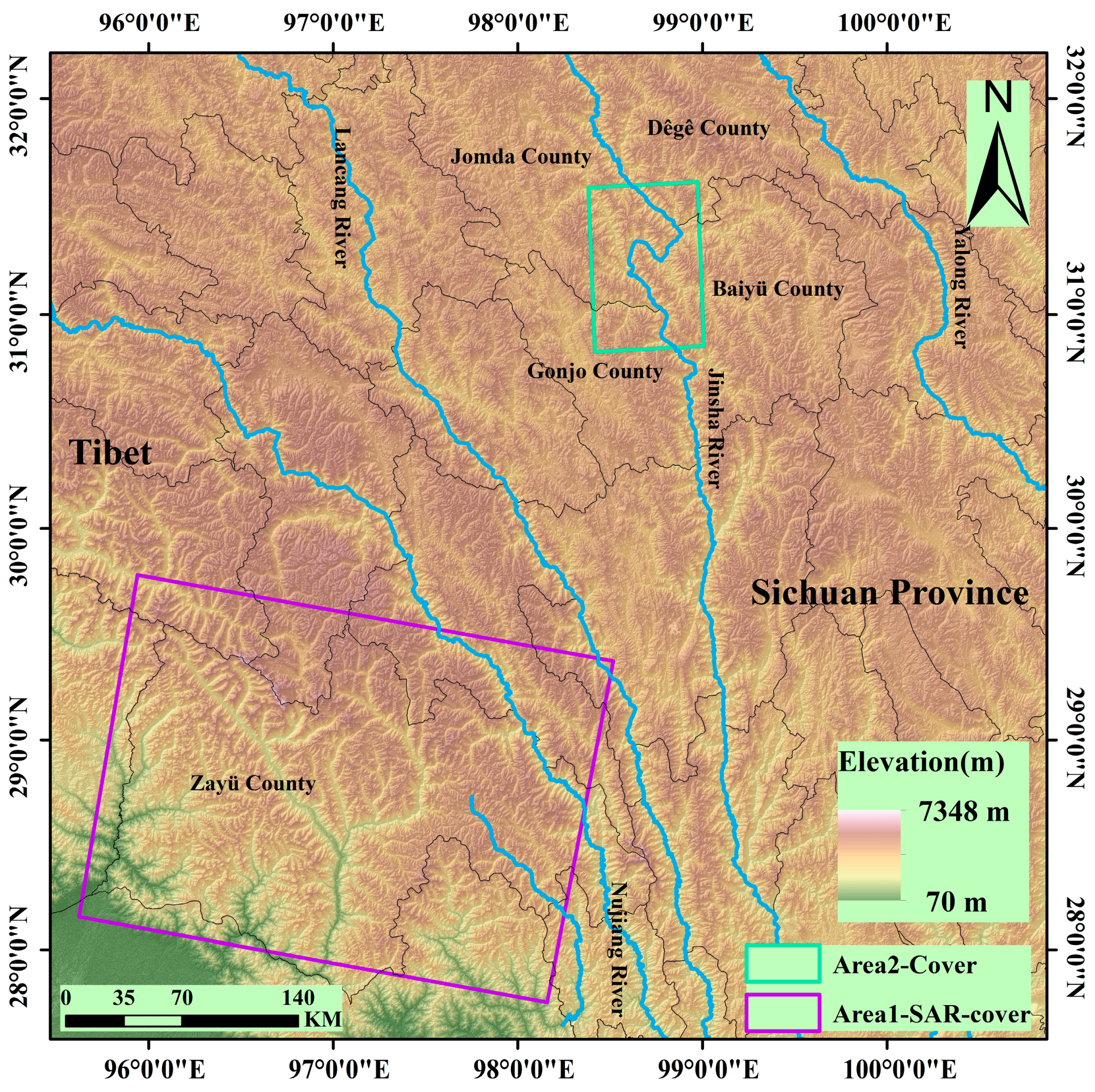

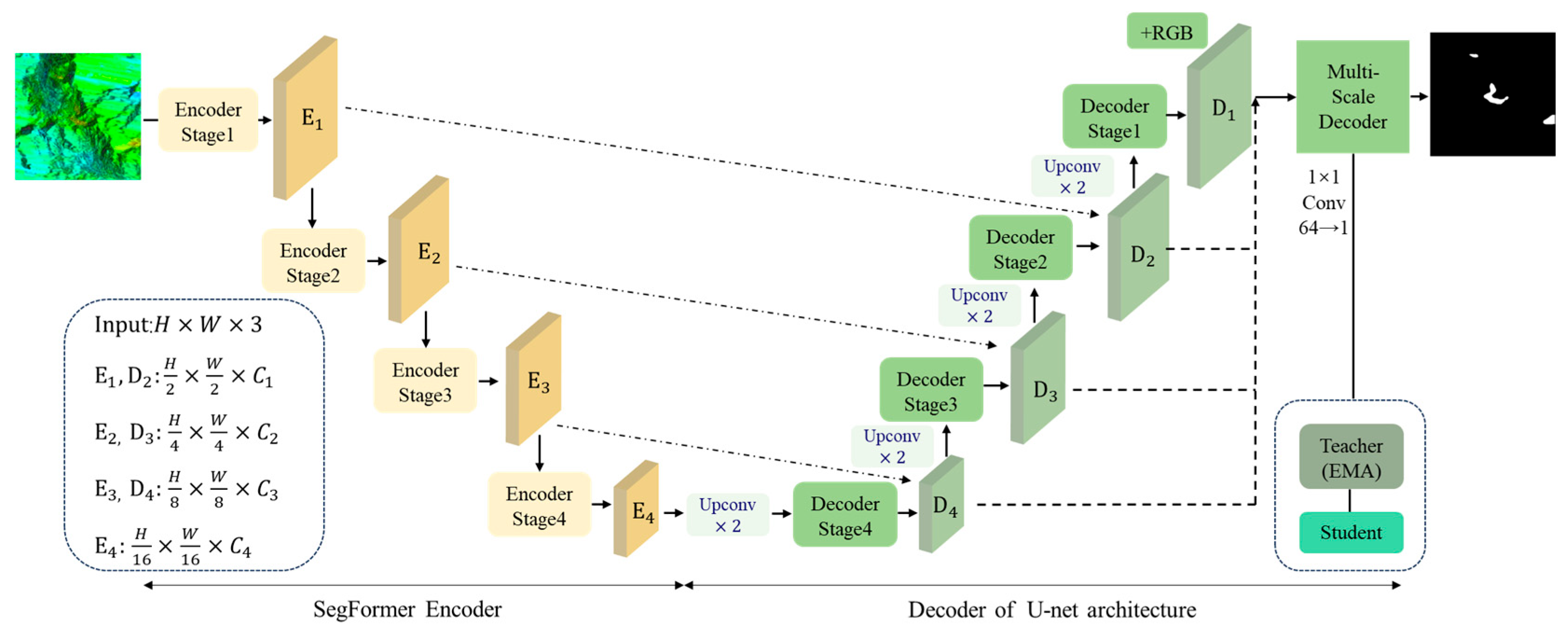

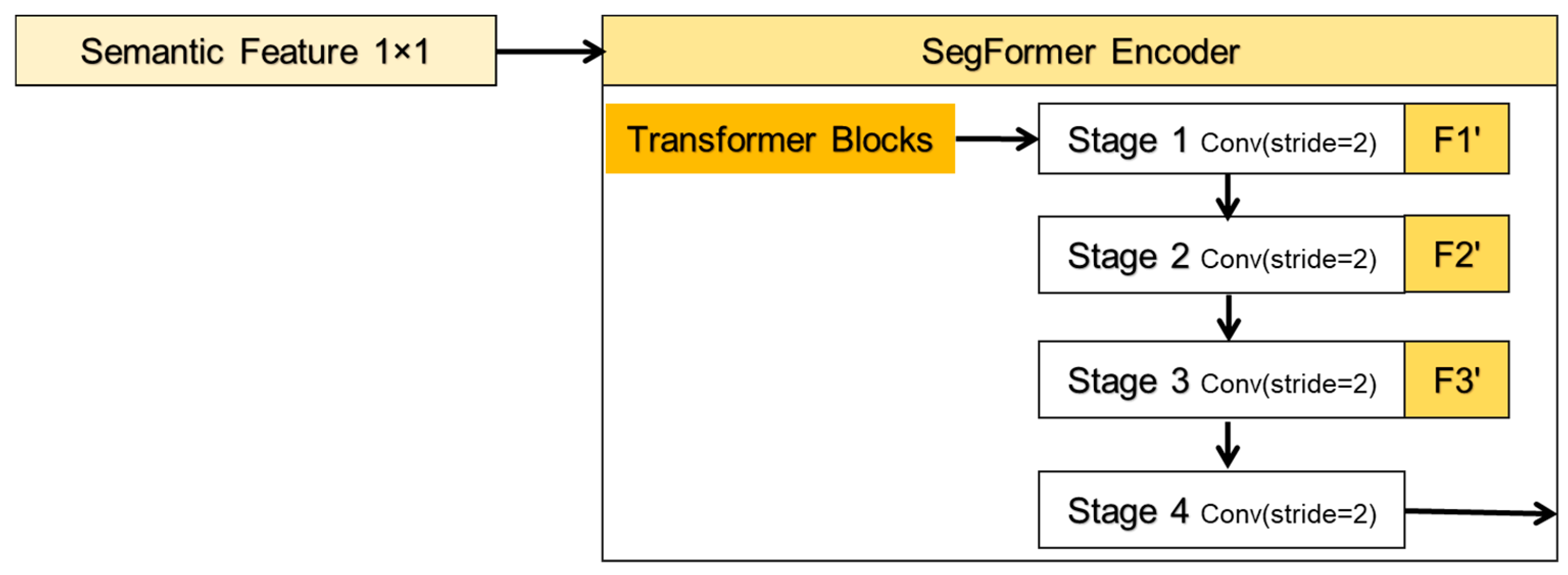
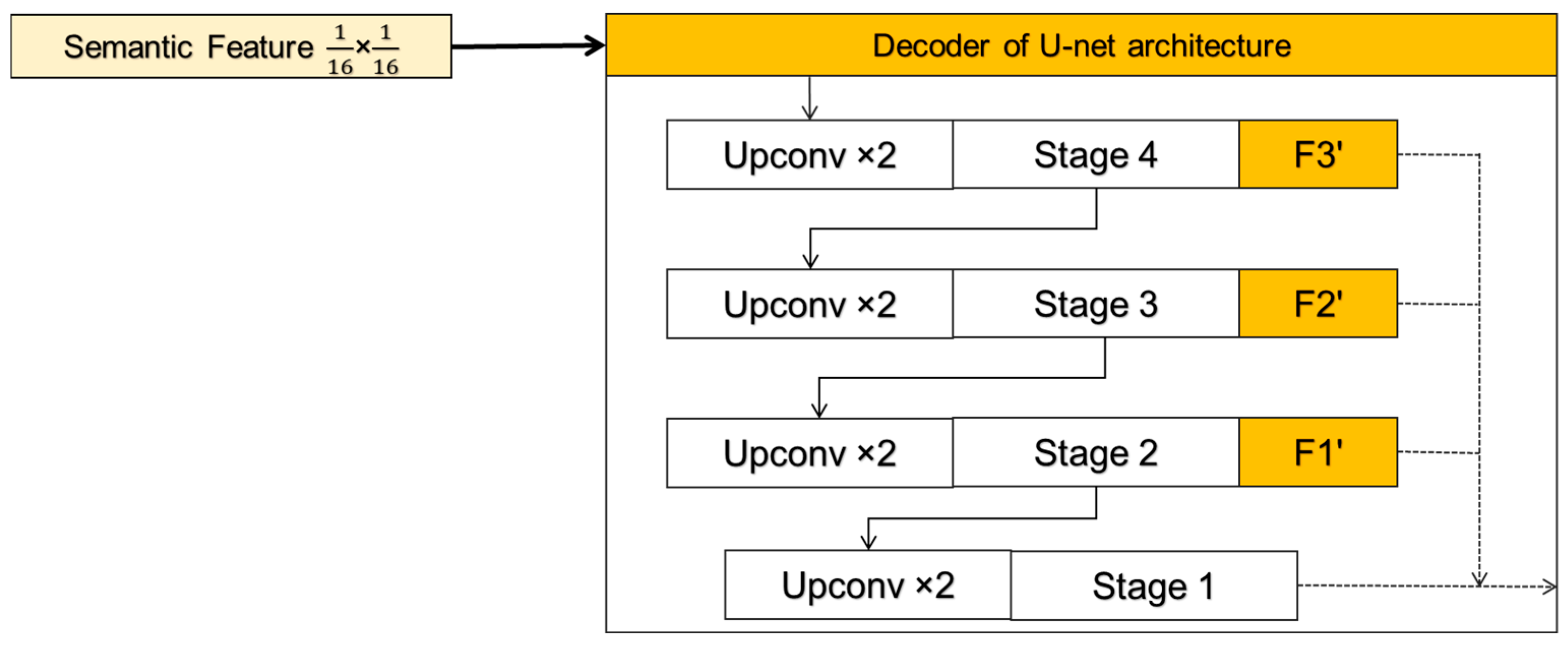

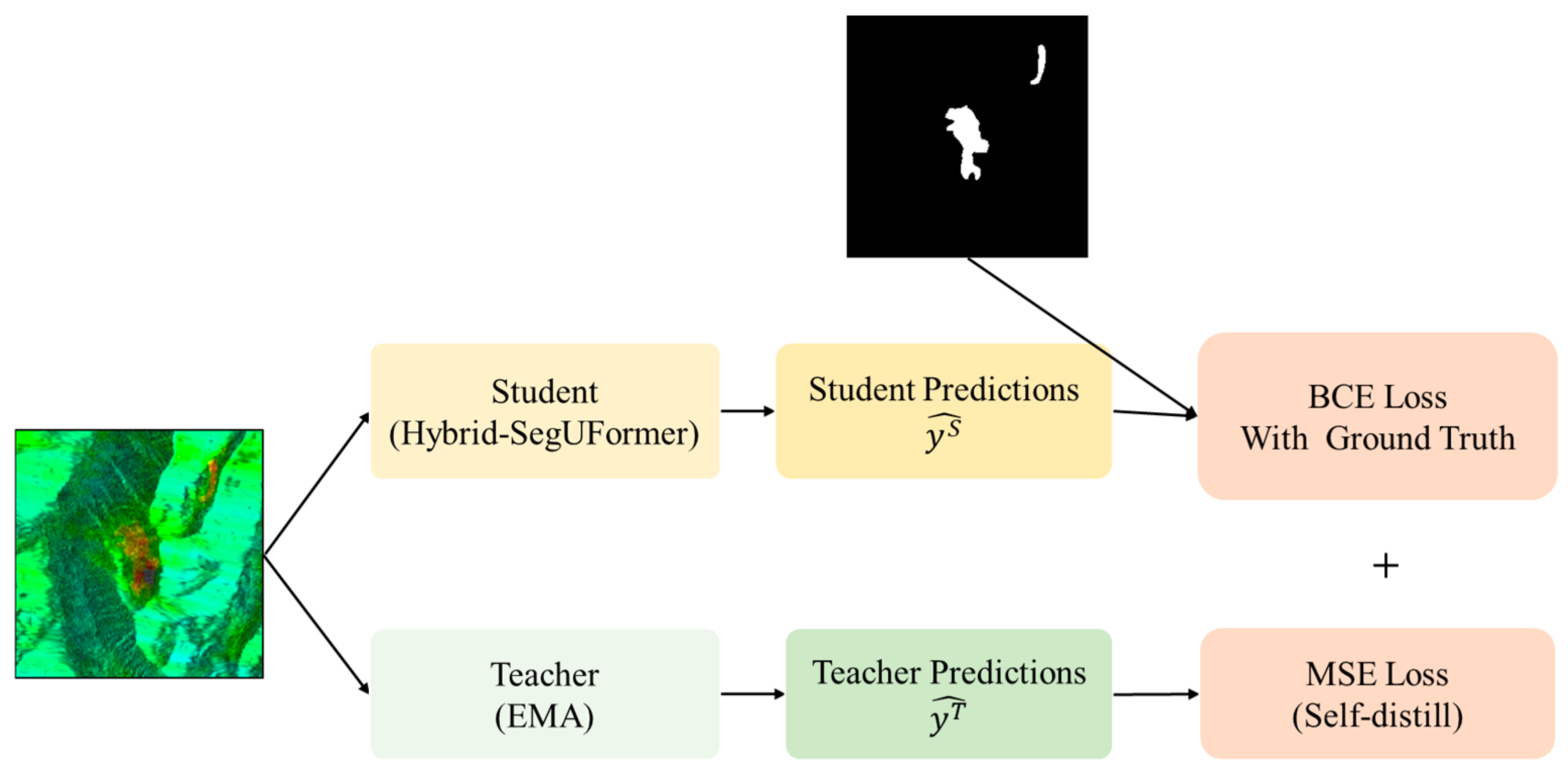
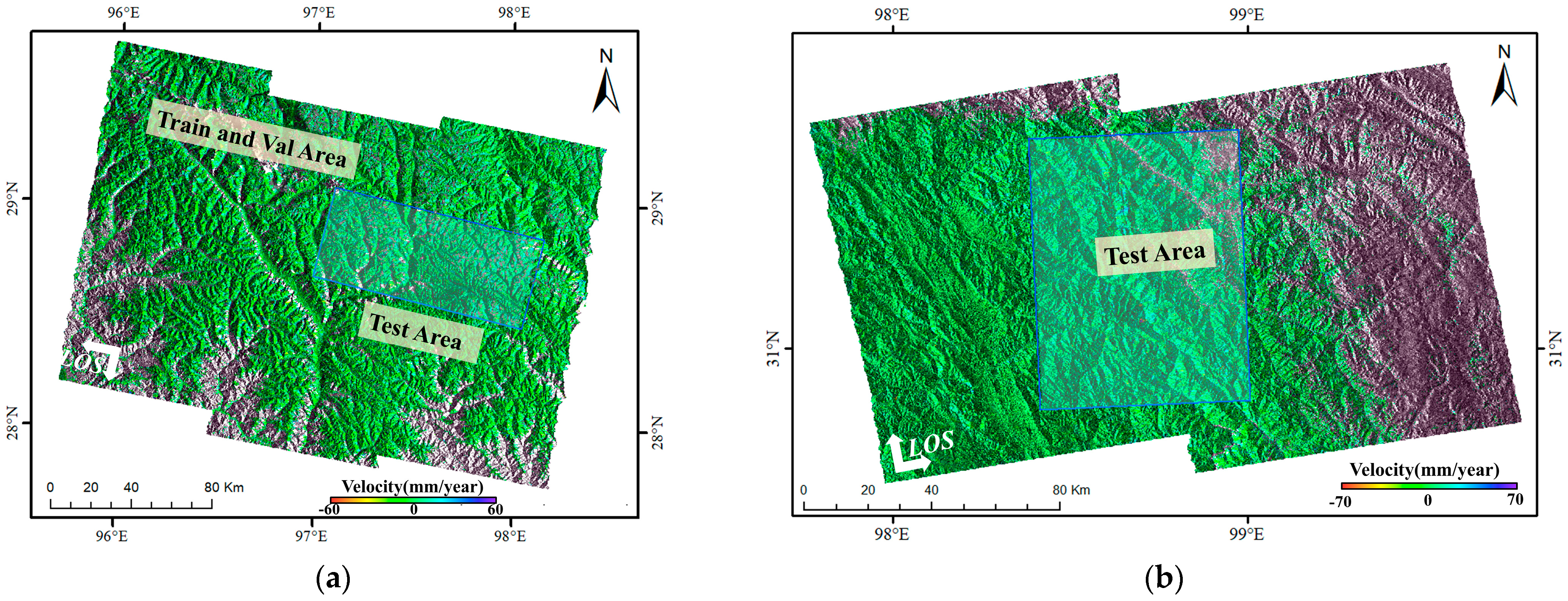
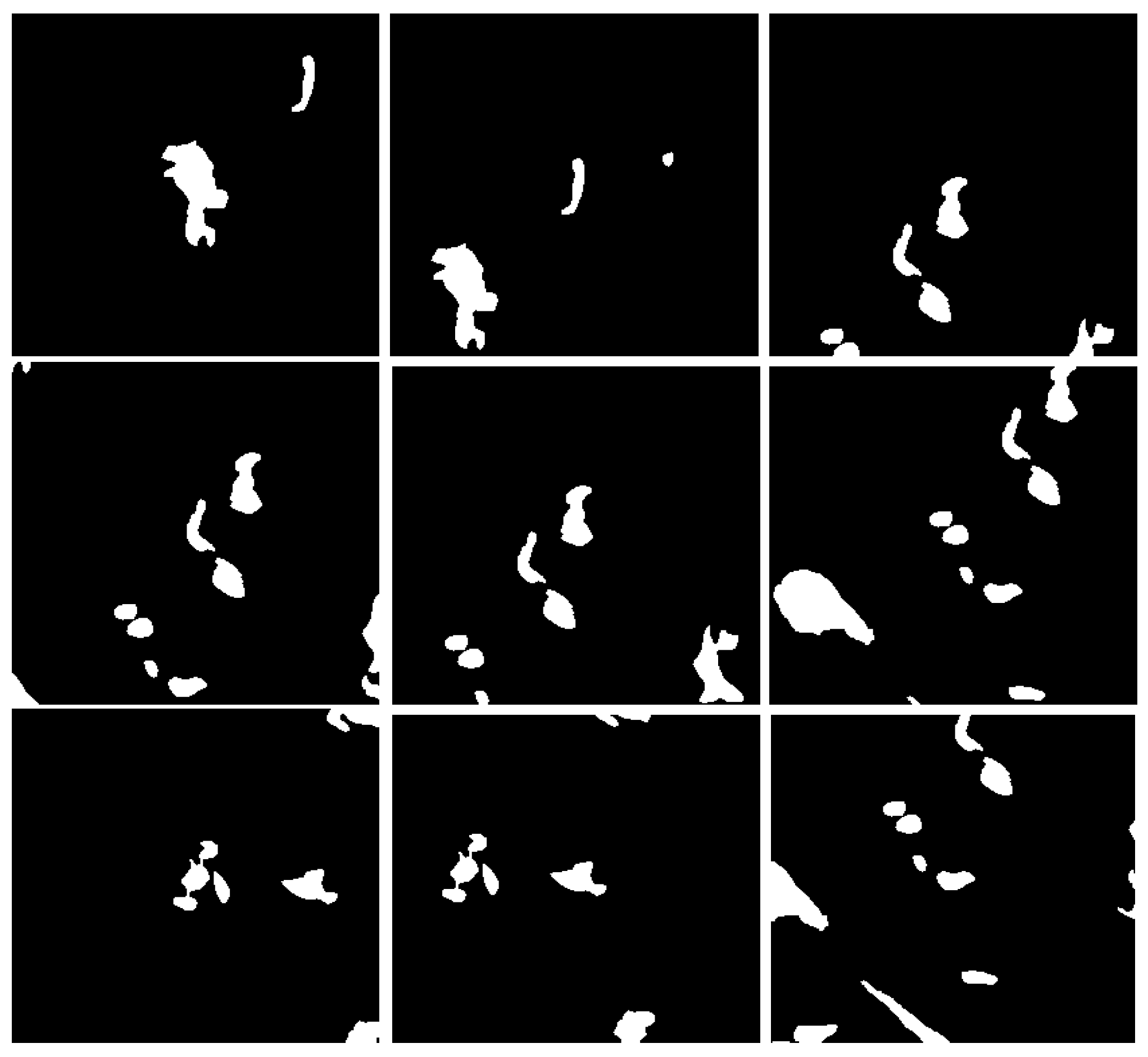
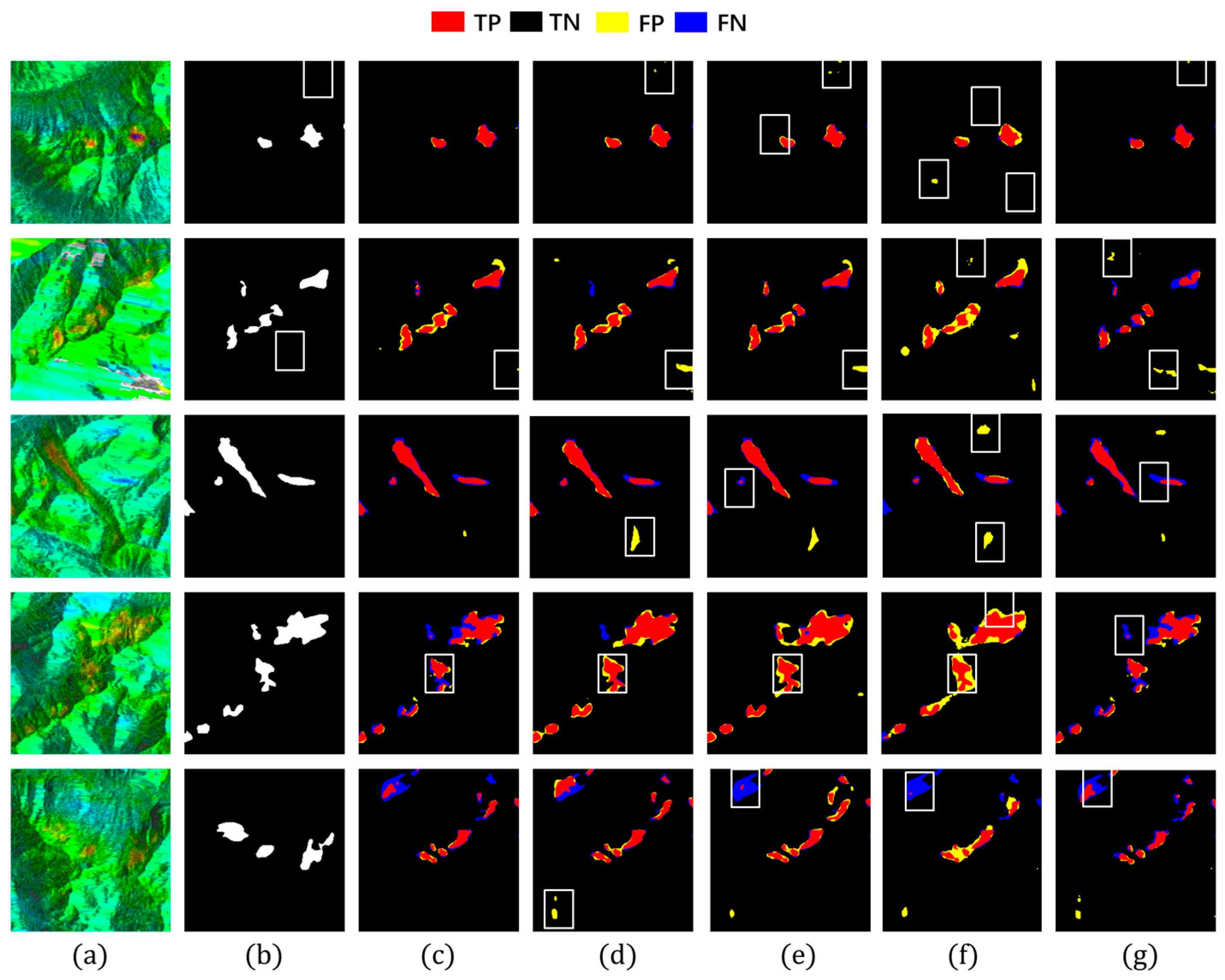
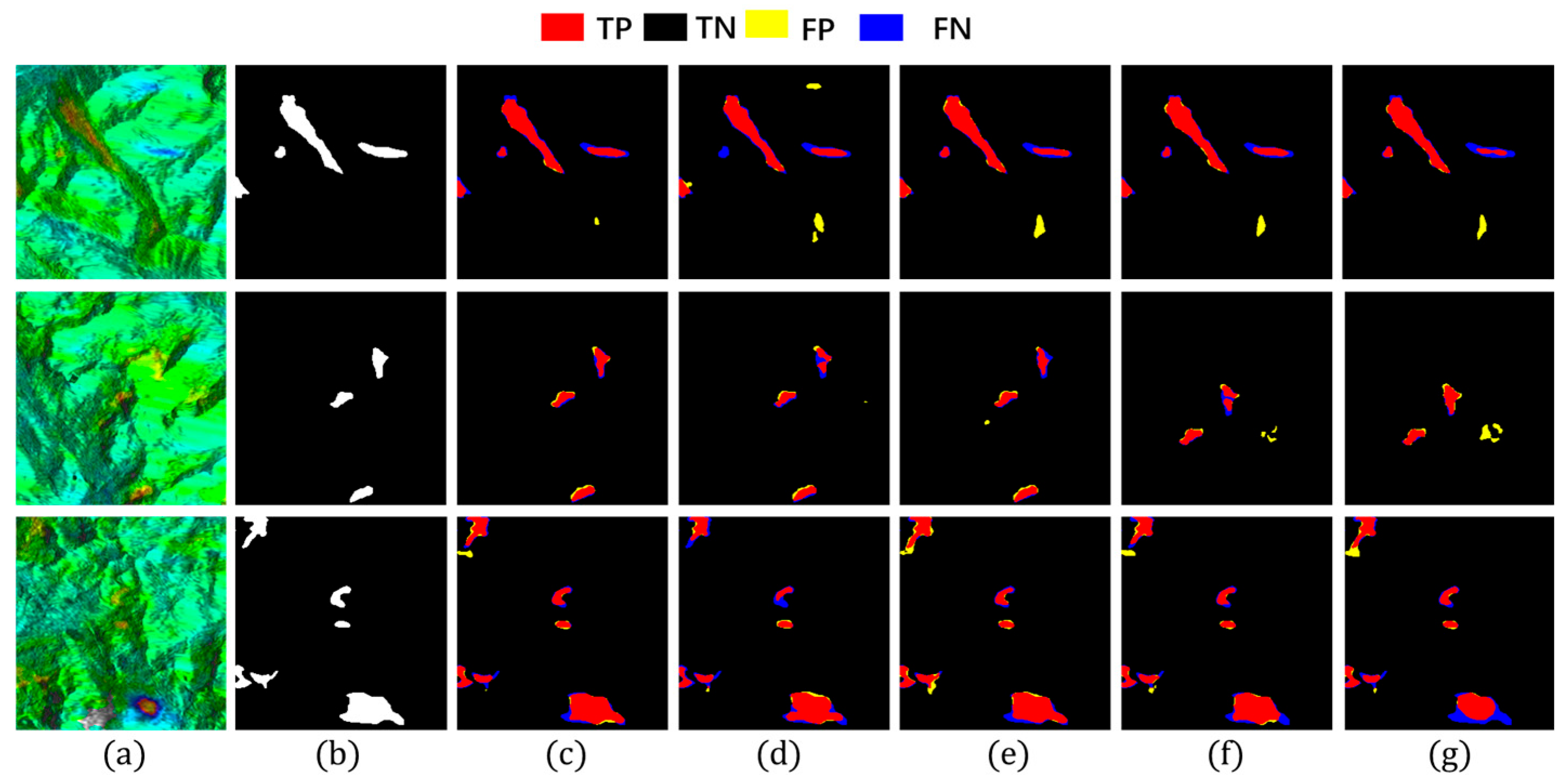
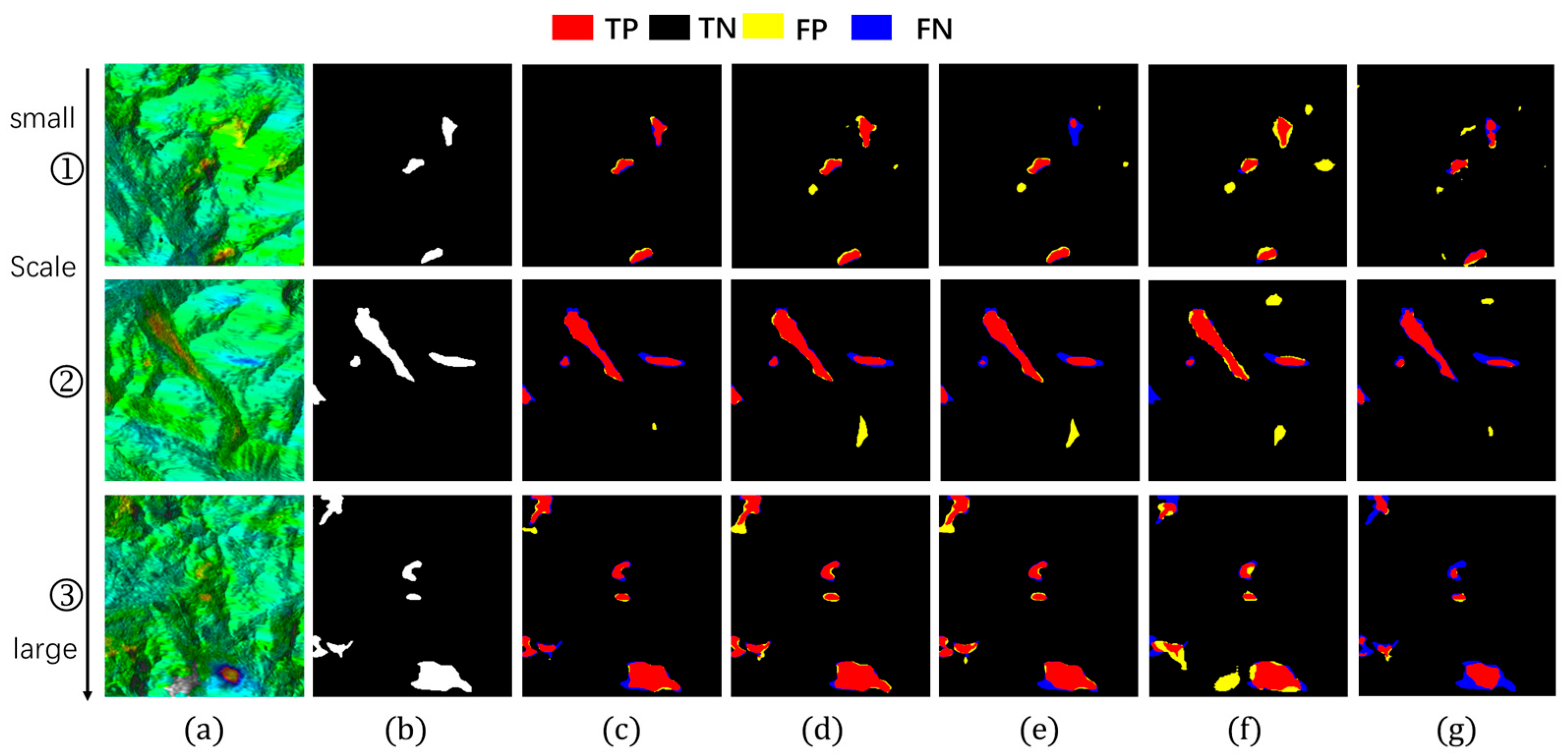
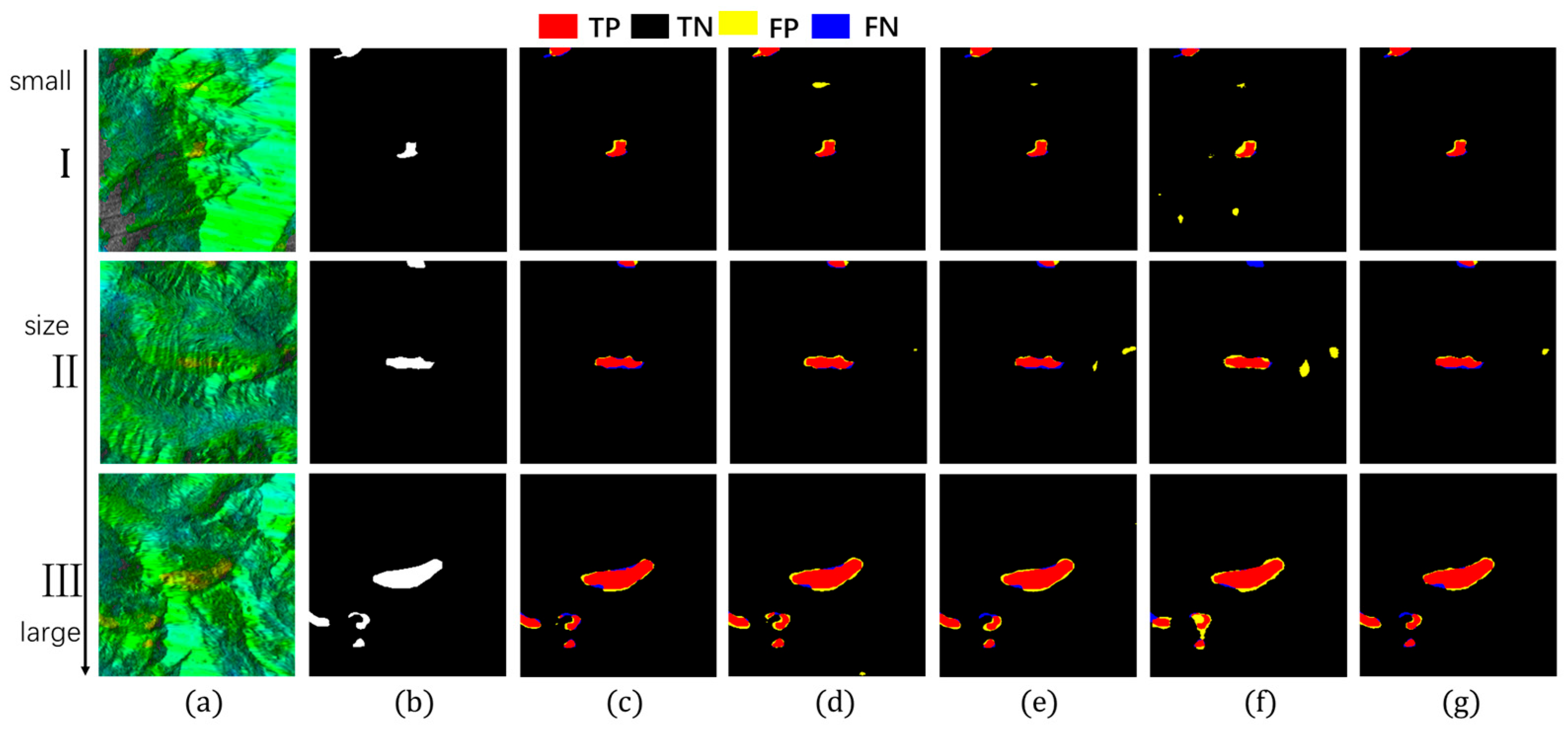
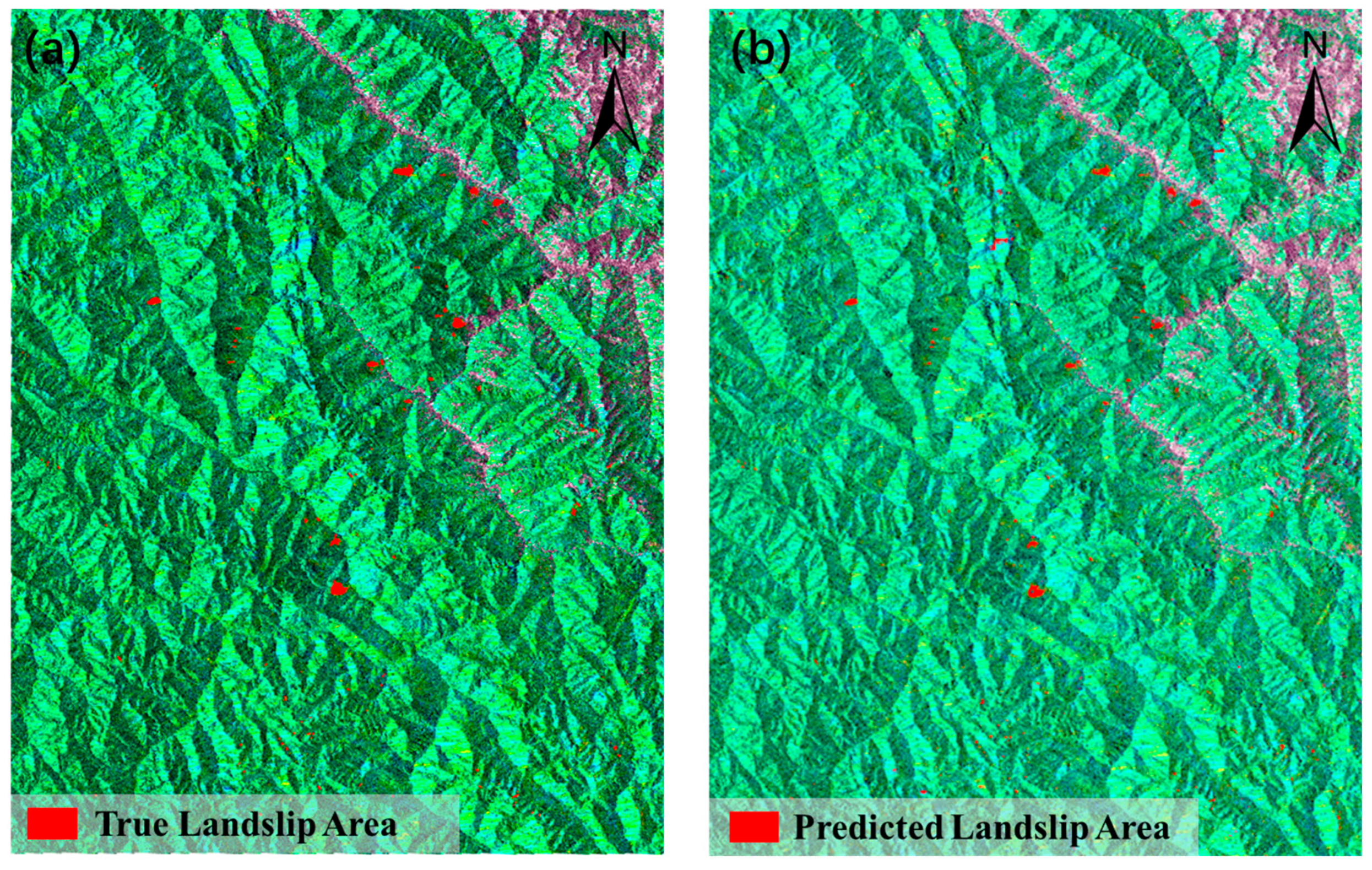

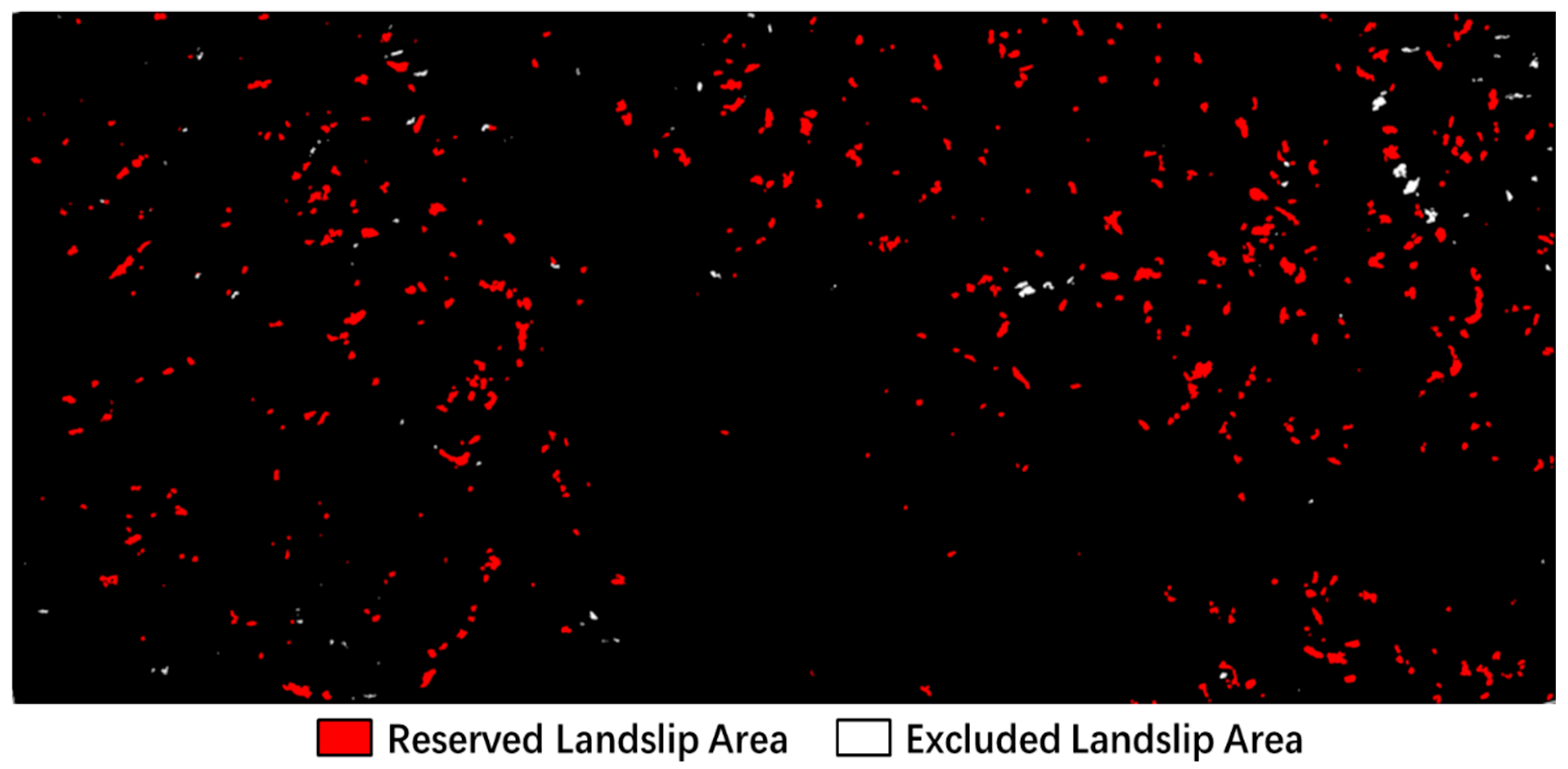
| Sensor | Polarization | Acquisition Mode | Wavelength | Spatial Resolution | Timespan | Direction | Path | Number of Images |
|---|---|---|---|---|---|---|---|---|
| Sentinel-1A | VV | IW | 5.6 cm (C band) | 5 m × 20 m | 2020.01~2022.11 | Descending | 106 | 80 |
| Sensor | Polarization | Acquisition Mode | Wavelength | Spatial Resolution | Timespan | Direction | Path | Number of Images |
|---|---|---|---|---|---|---|---|---|
| Sentinel-1A | VV | IW | 5.6 cm (C band) | 5 m × 20 m | 2017.04~2019.06 | Ascending | 99 | 66 |
| Components | Nomenclature |
|---|---|
| Hybrid | “Hybrid” signifies that the model integrates multiple architectures (Transformer + CNN), incorporates MSD and self-distillation mechanism, thereby highlighting its architectural hybridity. |
| Seg | “Seg” denotes application to semantic segmentation tasks (Segmentation). |
| U | “U” embodies the incorporation of the U-Net decoder architecture. |
| Former | “Former” signifies the Transformer encoder (from the SegFormer series). |
| Number | Accuracy (%) | Precision (%) | Recall (%) | IOU (%) | F1 (%) |
|---|---|---|---|---|---|
| ① | 98.79 | 81.78 | 78.39 | 66.74 | 80.05 |
| ② | 98.71 | 80.39 | 78.95 | 66.20 | 79.66 |
| ③ | 98.69 | 79.62 | 79.53 | 66.08 | 79.57 |
| ④ | 98.72 | 80.37 | 79.52 | 66.59 | 79.94 |
| Average Value | 98.73 | 80.54 | 79.10 | 66.40 | 79.81 |
| Standard Deviation | 0.04 | 0.90 | 0.54 | 0.31 | 0.23 |
| Average Range | 98.73 ± 0.04 | 80.54 ± 0.90 | 79.10 ± 0.54 | 66.40 ± 0.31 | 79.81 ± 0.23 |
| Model | Accuracy (%) | Precision (%) | Recall (%) | IOU (%) | F1 (%) |
|---|---|---|---|---|---|
| Hybrid-SegUFormer | 98.79 | 81.78 | 79.52 | 66.74 | 80.05 |
| U-net | 98.65 | 75.89 | 82.52 | 65.38 | 79.06 |
| DeepLabv3+ | 98.66 | 78.25 | 78.56 | 64.48 | 78.40 |
| Mask R-CNN | 98.22 | 64.57 | 80.25 | 55.71 | 71.56 |
| SegFormer | 98.69 | 79.34 | 77.37 | 64.40 | 78.34 |
| Targets | Hybrid-SegUFormer | U-net | DeepLabv3+ | Mask R-CNN | SegFormer |
|---|---|---|---|---|---|
| Params(M) | 12.55 | 7.77 | 39.63 | 43.92 | 27.35 |
| Flops(G) | 32.56 | 13.75 | 164.12 | 133.92 | 16.77 |
| Inference Time (Ms/Img) | 125.27 | 7.4 | 105.54 | 84.14 | 18.04 |
| Figure Label | Submodule | Evaluation Metrics | ||||||
|---|---|---|---|---|---|---|---|---|
| SegFormer Encoder | MSD | Self-Distill | Accuracy (%) | Precision (%) | Recall (%) | IoU (%) | F1 (%) | |
| (c) | √ | √ | √ | 98.79 | 81.78 | 78.39 | 66.74 | 80.05 |
| (d) | √ | √ | 98.74 | 81.49 | 76.87 | 65.44 | 79.11 | |
| (e) | √ | √ | 98.74 | 80.97 | 77.64 | 65.54 | 79.18 | |
| (f) | √ | √ | 98.73 | 80.14 | 78.30 | 65.58 | 79.21 | |
| (g) | √ | 98.78 | 83.49 | 75.33 | 65.57 | 79.20 | ||
| Image | Hybrid-SegUFormer | U-net | DeepLabV3+ | Mask R-CNN | SegFormer |
|---|---|---|---|---|---|
| ③ | 77.89 | 79.10 | 73.79 | 61.62 | 67.93 |
| ② | 76.28 | 71.98 | 68.27 | 60.13 | 62.02 |
| ① | 70.90 | 67.30 | 45.87 | 45.47 | 58.90 |
| Range | 6.99 | 11.80 | 27.92 | 16.15 | 19.03 |
| III | 81.03 | 76.63 | 77.64 | 69.67 | 80.95 |
| II | 74.43 | 76.06 | 62.60 | 48.96 | 68.05 |
| I | 72.20 | 64.88 | 73.22 | 50.31 | 74.31 |
| Range | 8.83 | 11.75 | 15.04 | 20.71 | 12.90 |
| Image | Hybrid-SegUFormer | U-net | DeepLabV3+ | Mask R-CNN | SegFormer |
|---|---|---|---|---|---|
| ③ | 83.44 | 91.69 | 85.05 | 81.48 | 57.26 |
| ② | 78.14 | 82.99 | 76.59 | 78.10 | 65.77 |
| ① | 81.70 | 94.66 | 59.94 | 89.22 | 74.68 |
| III | 91.14 | 95.43 | 93.22 | 93.99 | 93.02 |
| II | 79.10 | 89.11 | 77.34 | 78.18 | 77.56 |
| I | 86.87 | 93.71 | 90.47 | 87.10 | 87.41 |
| Image | Hybrid-SegUFormer | U-net | DeepLabV3+ | Mask R-CNN | SegFormer |
|---|---|---|---|---|---|
| ③ | 87.57 | 88.33 | 84.92 | 76.25 | 62.95 |
| ② | 86.55 | 83.71 | 81.15 | 75.10 | 76.56 |
| ① | 82.97 | 67.30 | 62.90 | 62.51 | 72.53 |
| III | 89.52 | 86.77 | 87.41 | 82.12 | 89.47 |
| II | 85.34 | 86.40 | 62.60 | 65.73 | 80.99 |
| I | 83.85 | 78.70 | 84.54 | 66.94 | 85.26 |
| Image | Hybrid-SegUFormer | w/o Self-Distillation |
|---|---|---|
| Big Scale | 77.57 | 76.95 |
| Small Scale | 75.21 | 73.87 |
| Range | 2.36 | 3.08 |
| Image | Hybrid-SegUFormer | w/o Self-Distillation |
|---|---|---|
| Big Scale | 89.13 | 90.30 |
| Small Scale | 84.85 | 88.47 |
| Range | 4.28 | 1.83 |
| Image | Hybrid-SegUFormer | w/o Self-Distillation |
|---|---|---|
| Big Scale | 87.34 | 86.93 |
| Small Scale | 85.72 | 84.31 |
| Range | 1.62 | 2.62 |
| Model | Accuracy (%) | Precision (%) | Recall (%) | IOU (%) | F1 (%) |
|---|---|---|---|---|---|
| Hybrid-SegUFormer | 98.92 | 89.81 | 75.42 | 69.47 | 81.99 |
| U-net | 98.90 | 88.15 | 76.47 | 69.34 | 81.89 |
| DeepLabv3+ | 98.85 | 90.87 | 71.94 | 67.09 | 80.31 |
| Mask R-CNN | 98.84 | 87.91 | 74.59 | 67.66 | 80.71 |
| SegFormer | 98.45 | 87.88 | 60.76 | 56.06 | 71.84 |
| Number | Accuracy (%) | Precision (%) | Recall (%) | IOU (%) | F1 (%) |
|---|---|---|---|---|---|
| ① | 98.92 | 89.81 | 75.42 | 69.47 | 81.99 |
| ② | 98.90 | 88.00 | 76.68 | 69.42 | 81.95 |
| ③ | 98.85 | 88.11 | 75.12 | 68.21 | 81.10 |
| ④ | 98.90 | 88.33 | 76.64 | 69.59 | 82.07 |
| Average Value | 98.89 | 88.56 | 75.97 | 69.17 | 81.78 |
| Standard Deviation | 0.03 | 0.84 | 0.81 | 0.65 | 0.45 |
| Average Range | 98.89 ± 0.03 | 88.56 ± 0.84 | 75.97 ± 0.81 | 69.17 ± 0.65 | 81.78 ± 0.45 |
Disclaimer/Publisher’s Note: The statements, opinions and data contained in all publications are solely those of the individual author(s) and contributor(s) and not of MDPI and/or the editor(s). MDPI and/or the editor(s) disclaim responsibility for any injury to people or property resulting from any ideas, methods, instructions or products referred to in the content. |
© 2025 by the authors. Licensee MDPI, Basel, Switzerland. This article is an open access article distributed under the terms and conditions of the Creative Commons Attribution (CC BY) license (https://creativecommons.org/licenses/by/4.0/).
Share and Cite
Zhao, W.; Zhang, J.; Cai, J.; Ming, D. Hybrid-SegUFormer: A Hybrid Multi-Scale Network with Self-Distillation for Robust Landslide InSAR Deformation Detection. Remote Sens. 2025, 17, 3514. https://doi.org/10.3390/rs17213514
Zhao W, Zhang J, Cai J, Ming D. Hybrid-SegUFormer: A Hybrid Multi-Scale Network with Self-Distillation for Robust Landslide InSAR Deformation Detection. Remote Sensing. 2025; 17(21):3514. https://doi.org/10.3390/rs17213514
Chicago/Turabian StyleZhao, Wenyi, Jiahao Zhang, Jianao Cai, and Dongping Ming. 2025. "Hybrid-SegUFormer: A Hybrid Multi-Scale Network with Self-Distillation for Robust Landslide InSAR Deformation Detection" Remote Sensing 17, no. 21: 3514. https://doi.org/10.3390/rs17213514
APA StyleZhao, W., Zhang, J., Cai, J., & Ming, D. (2025). Hybrid-SegUFormer: A Hybrid Multi-Scale Network with Self-Distillation for Robust Landslide InSAR Deformation Detection. Remote Sensing, 17(21), 3514. https://doi.org/10.3390/rs17213514








